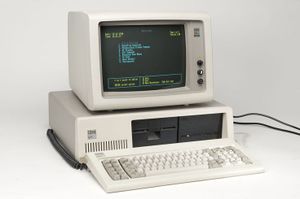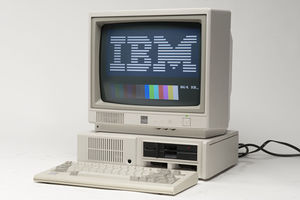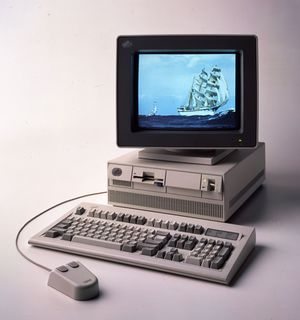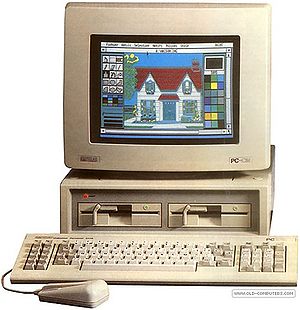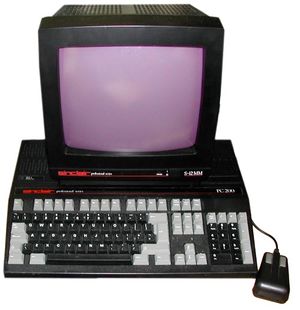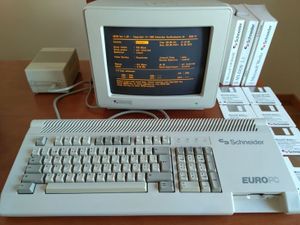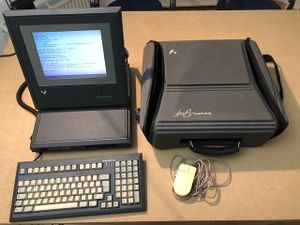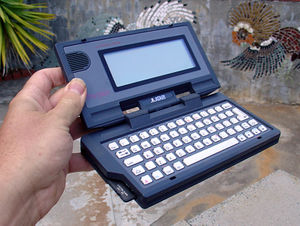Difference between revisions of "PC"
(→Links) |
|||
| (43 intermediate revisions by the same user not shown) | |||
| Line 1: | Line 1: | ||
| − | [[ | + | [[File:IBM PC 5150.jpg|thumb|right|IBM PC Model 5150]] |
| − | [[ | + | [[File:IBM PCjr.jpg|thumb|right|IBM PCjr]] |
| − | [[ | + | [[File:IBM PS2.jpeg|thumb|right|IBM PS/2]] |
| − | [[Image:Amstrad | + | [[Image:Amstrad pc1512-2.jpg|thumb|right|The '''Amstrad PC1512''' - The first PC by Amstrad]] |
| − | [[ | + | [[File:Sinclair PC200.jpg|thumb|right|Sinclair PC200]] |
| + | |||
| + | [[File:Schneider EuroPC.jpg|thumb|right|Schneider EuroPC]] | ||
| + | |||
| + | [[File:Goupil-Golf-Computer-286.jpg|thumb|right|Goupil Golf - A transportable PC]] | ||
| + | |||
| + | [[File:Atari Portfolio.jpg|thumb|right|Atari Portfolio - A palmtop PC]] | ||
| Line 26: | Line 32: | ||
== Amstrad and PCs == | == Amstrad and PCs == | ||
| − | [[Amstrad PC]] | + | See: [[Amstrad PC]] article |
List of Amstrad PCs: | List of Amstrad PCs: | ||
| Line 32: | Line 38: | ||
* PC1512 (1985) | * PC1512 (1985) | ||
* PC1640 (1987) | * PC1640 (1987) | ||
| − | * | + | * PPC512 / PPC640 (1987) |
* Amstrad PC20 / Sinclair PC200 (1988) | * Amstrad PC20 / Sinclair PC200 (1988) | ||
* PC2000 series (PC2086, PC2286, PC2386) (1989) | * PC2000 series (PC2086, PC2286, PC2386) (1989) | ||
| Line 64: | Line 70: | ||
== Links == | == Links == | ||
| − | *[http://en.wikipedia.org/wiki/IBM_Personal_Computer IBM Personal Computer] [http://en.wikipedia.org/wiki/IBM_PC_compatible IBM PC compatible | + | *[http://en.wikipedia.org/wiki/IBM_Personal_Computer IBM Personal Computer] [http://en.wikipedia.org/wiki/IBM_PC_compatible IBM PC compatible] Wikipedia articles |
| − | *[https://www.seasip.info/ | + | *[https://www.seasip.info/VintagePC/index.html Vintage PCs] [https://www.seasip.info/VintagePC/cga.html Color Graphics Adapter: Notes] |
| − | *[https:// | + | *[https://youtu.be/xNsK_F4JlG4 Meet the "Super CGA" Cards] by [[The 8-Bit Guy]] |
| − | + | *[https://youtu.be/niKblgZupOc CGA Graphics - Not as bad as you thought] by [[The 8-Bit Guy]] | |
| − | *[https:// | + | *[https://int10h.org/blog/2015/04/cga-in-1024-colors-new-mode-illustrated/ CGA in 1024 colors: the illustrated guide] |
| − | + | *[https://int10h.org/blog/2023/07/martypc-pc-xt-emulator-raising-the-bar/ Raising the bar for IBM PC/XT emulation: MartyPC] [https://martypc.blogspot.com/ Blog] | |
| − | *[https://youtu.be/ | + | *[https://devtidbits.com/2008/03/16/dosbox-graphic-and-machine-emulation-cga-vga-tandy-pcjr-hercules/ Graphics cards] [https://devtidbits.com/2008/04/26/dosbox-sound-emulation/ Sound cards] in DOSBox |
| − | + | *[https://youtu.be/BMmFcs-_4x4 The Best Sound for MS-DOS Games - Roland MT-32] by [[8-Bit Keys]] | |
| − | *[https:// | + | *[https://youtu.be/Vmf2oRKiR2A La PicoGUS et la Gravis Ultrasound] [https://youtu.be/urBkxpwz69Q The PicoMEM, one card to rule them all] by [[Rodrik Studio]] |
| − | + | *[https://youtu.be/kPtytEHOZlg What were XMS, EMS and Conventional memory and why did the PC have them?] by [[TimberwolfK]] | |
*[https://www.tutorialspoint.com/microprocessor/index.htm Microprocessor tutorial] | *[https://www.tutorialspoint.com/microprocessor/index.htm Microprocessor tutorial] | ||
*[https://wiki.osdev.org/Expanded_Main_Page OSDev Wiki] [https://www.seasip.info/Gem/ Intel GEM] | *[https://wiki.osdev.org/Expanded_Main_Page OSDev Wiki] [https://www.seasip.info/Gem/ Intel GEM] | ||
| − | * | + | *Evolution of PC graphics and sound as told by [https://youtu.be/xo2_ksqxbiQ The Secret of Monkey Island] |
| − | + | ||
| − | + | ||
| − | + | ||
| − | + | ||
*[https://youtu.be/kn06jcwRAs4 All 1980's] [https://youtu.be/mcIe6gSv5bM All 1990-1992] [https://youtu.be/2dXNTb2OsIo All 1993-1995] DOS games in one video | *[https://youtu.be/kn06jcwRAs4 All 1980's] [https://youtu.be/mcIe6gSv5bM All 1990-1992] [https://youtu.be/2dXNTb2OsIo All 1993-1995] DOS games in one video | ||
| + | *[https://youtu.be/js0bvdvVDiQ 1982] [https://youtu.be/O5hLisvOvxA 1983] [https://youtu.be/q-s4Tvf_sCQ 1984] [https://youtu.be/kpgwq_rYgDE 1985] [https://youtu.be/rWhpLJdIsD0 1986] [https://youtu.be/nq9qDHmRkfs 1987] [https://youtu.be/voQtOQTJGdQ 1988] [https://youtu.be/2NbvRZokV2g 1989] [https://youtu.be/TbTS4JW0th8 1990] [https://youtu.be/Lbk5Tg82A7o 1991] [https://youtu.be/5n7dyvSQJno 1992] [https://youtu.be/WeQAZbMwlHc 1993] Top MS-DOS games | ||
*[https://www.retro-exo.com/ Retro eXo] Home of eXoDOS, eXoWin3x, eXoScummVM game archives | *[https://www.retro-exo.com/ Retro eXo] Home of eXoDOS, eXoWin3x, eXoScummVM game archives | ||
| + | *[https://www.dosdays.co.uk/ DOS Days] History and technical details of the hardware of DOS-era PCs | ||
| + | *[https://lennartb.home.xs4all.nl/coreboot/col2.html A brief history of the PC platform from 1981 to 2011] | ||
| + | *[https://www.nand2tetris.org/ From Nand to Tetris] [https://github.com/jherskow/nand2tetris/blob/master/nand2tetris%20BOOK.pdf The elements of computing systems ebook] | ||
| + | *[https://classic.copetti.org/writings/consoles/ Architecture of Consoles] | ||
| + | *[https://youtu.be/nw2QfPREu-Q Sharp pixels vs CRT pixels] | ||
| + | *[http://homecomputer.de/pages/f_gallery.html Home Computer Museum] 797 home computer models of the 1980s with photo | ||
| + | *[https://www.youtube.com/watch?v=wdUa20kUXM8&list=PLIX9fyYxV0k_NtBiHZtXs_UIccGTbnAjz PC vs Amiga] | ||
[[Category:Non CPC Computers]] | [[Category:Non CPC Computers]] | ||
Latest revision as of 21:28, 17 May 2025
PC stands for "Personal Computer". The term was coined in the 70s for machines that are used directly by one person at a time. This was a huge paradigm shift over the big and expensive mainframe computers that were common at the time. Early examples of Personal Computers include the Apple II and the Commodore PET.
Nowadays the term PC usually refers to IBM compatible PCs. IBM built the original IBM PC in 1981, later followed by the IBM PC/XT in 1983 and the IBM PC/AT in 1984. Since IBM decided to open up the design other manufacturers started to sell clones of the original IBM PC and it's successors, so called "IBM compatibles". This allowed the IBM PC architecture to quickly become the industry standard for Personal Computers intended for business oriented tasks.
The IBM PC is the ancestor of most modern desktop and laptop computers. In the early 80s, PCs were rather expensive and not really suited for multimedia. They were not often used as home computers. This changed throughout the 90s when better graphics and sound cards appeared, PCs became cheaper and modern operating systems made them easier to use.
Although the name Amstrad CPC is an abrivation for Color Personal Computer, the Amstrad CPC was not an IBM compatible PC. But unlike many other homecomputers of the era, the Amstrad CPC shared many components which also was found in first IBM PCs and compatibles of the 80's:
- CRTC (found on CGA cards)
- FDC The PC used the same Floppy Disc Controler.
- PPI Same programmable peripheral interface as the CPC
Amstrad and PCs
See: Amstrad PC article
List of Amstrad PCs:
- PC1512 (1985)
- PC1640 (1987)
- PPC512 / PPC640 (1987)
- Amstrad PC20 / Sinclair PC200 (1988)
- PC2000 series (PC2086, PC2286, PC2386) (1989)
- MegaPC (1993)
- And many others.
GEM, a graphical desktop user interface primarily used on Atari ST, was shipped with some models of Amstrad PCs.
IBM Antitrust Consent Decree
In the early 1950s, IBM was the dominant player in the computing industry, particularly with its mainframe computers. The company held a substantial market share, leading to concerns about monopolistic practices and stifling competition.
The U.S. government, particularly the Department of Justice, initiated legal action against IBM in 1952, alleging that the company was violating antitrust laws by using its market power to suppress competition.
The Consent Decree, finalized in 1956, was not a traditional antitrust lawsuit but rather a settlement that aimed to modify IBM's business practices. Notably, the decree encouraged the development of open standards in computing, promoting interoperability among different systems.
It led to the PC architecture being functionally an open design, as IBM was required to share its technology and promote competition. Therefore, IBM used standard components and a flexible design, making it easy for other manufacturers to replicate.
This openness encouraged many companies like Amstrad to create compatible products, leading to rapid growth in the PC market. Software developers also benefited, as they could create programs that worked across various compatible machines.
And it explains why IBM did such a good job in documenting the PC architecture:
- IBM PC Internals Fundamentals Course
- IBM PC IBM PCjr IBM PC XT IBM PC AT Hardware Technical Reference
- IBM Disk Operating System Reference
Links
- IBM Personal Computer IBM PC compatible Wikipedia articles
- Vintage PCs Color Graphics Adapter: Notes
- Meet the "Super CGA" Cards by The 8-Bit Guy
- CGA Graphics - Not as bad as you thought by The 8-Bit Guy
- CGA in 1024 colors: the illustrated guide
- Raising the bar for IBM PC/XT emulation: MartyPC Blog
- Graphics cards Sound cards in DOSBox
- The Best Sound for MS-DOS Games - Roland MT-32 by 8-Bit Keys
- La PicoGUS et la Gravis Ultrasound The PicoMEM, one card to rule them all by Rodrik Studio
- What were XMS, EMS and Conventional memory and why did the PC have them? by TimberwolfK
- Microprocessor tutorial
- OSDev Wiki Intel GEM
- Evolution of PC graphics and sound as told by The Secret of Monkey Island
- All 1980's All 1990-1992 All 1993-1995 DOS games in one video
- 1982 1983 1984 1985 1986 1987 1988 1989 1990 1991 1992 1993 Top MS-DOS games
- Retro eXo Home of eXoDOS, eXoWin3x, eXoScummVM game archives
- DOS Days History and technical details of the hardware of DOS-era PCs
- A brief history of the PC platform from 1981 to 2011
- From Nand to Tetris The elements of computing systems ebook
- Architecture of Consoles
- Sharp pixels vs CRT pixels
- Home Computer Museum 797 home computer models of the 1980s with photo
- PC vs Amiga
